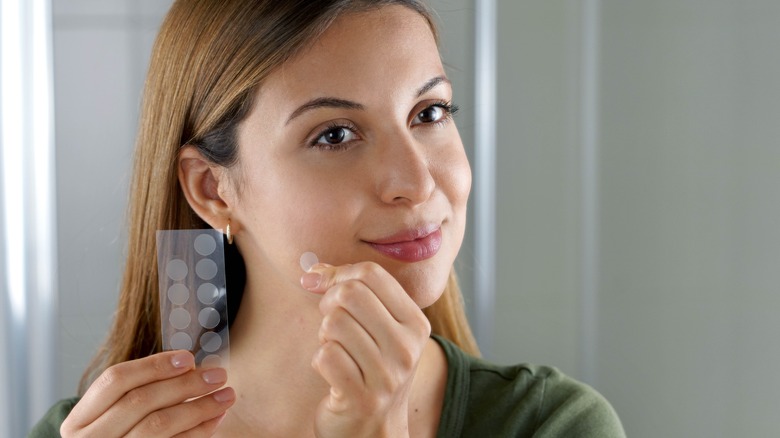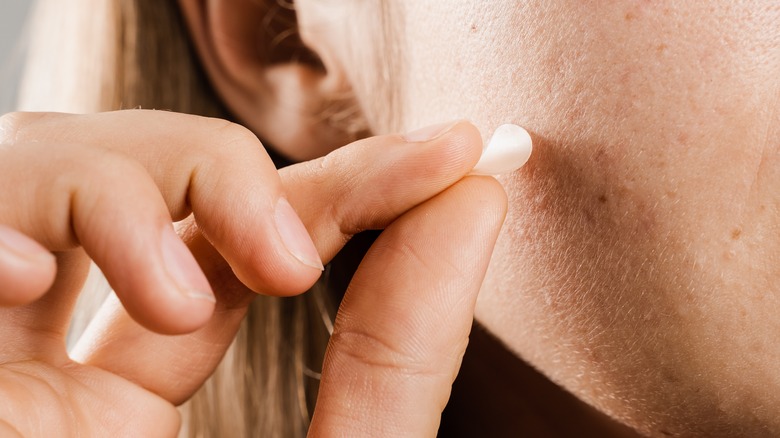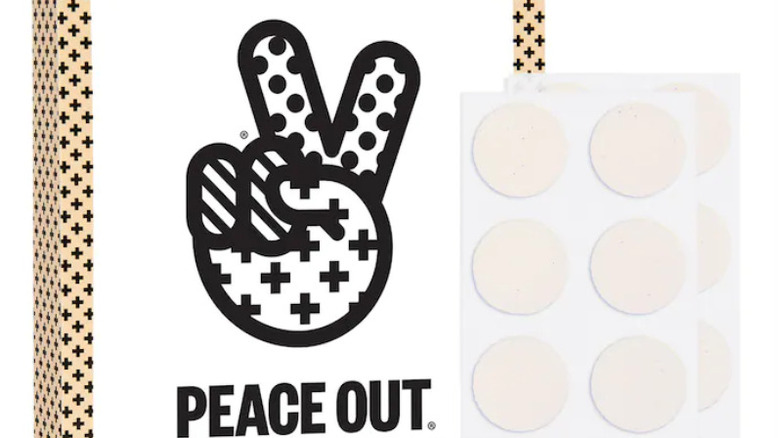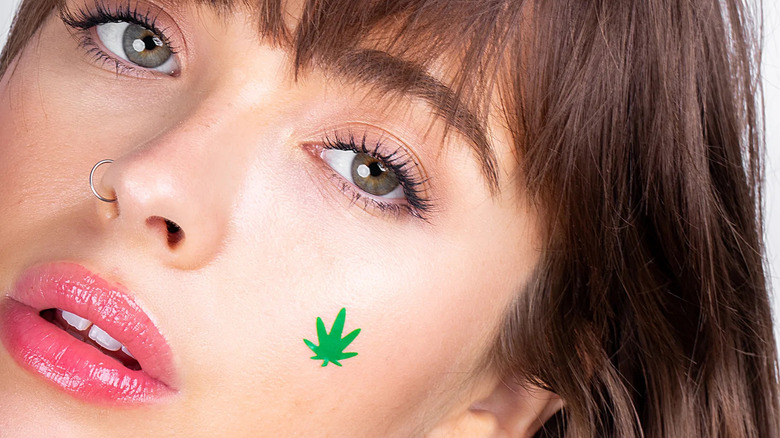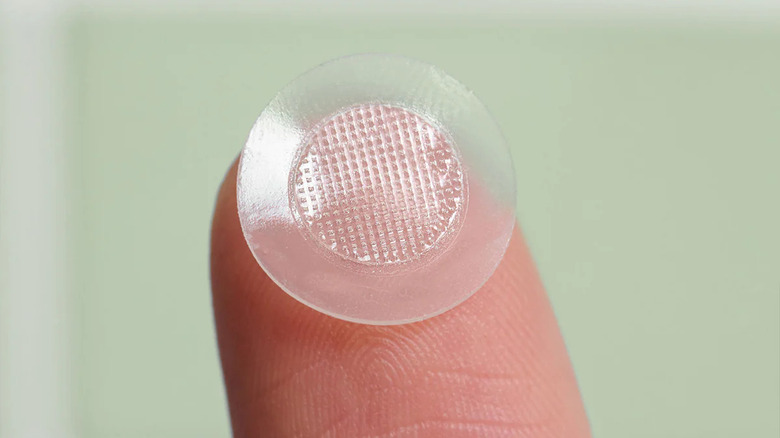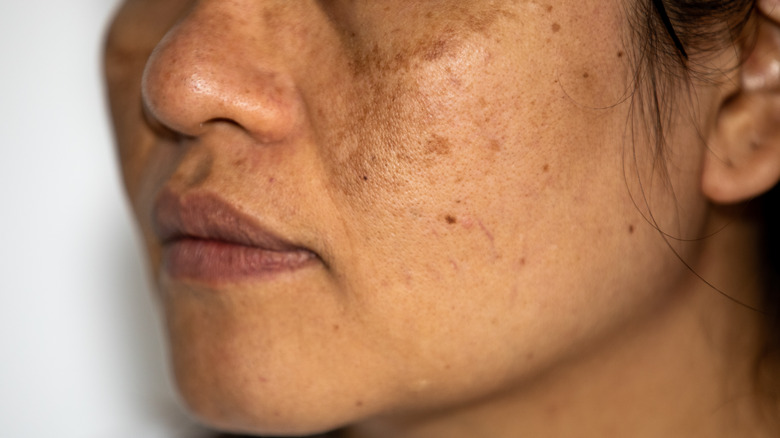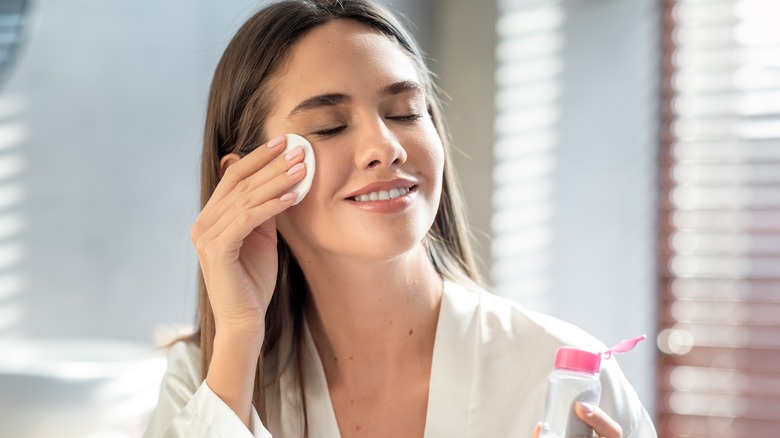There Are More Types Of Pimple Patches Than You Thought
We may receive a commission on purchases made from links.
Pimples are like door-to-door salespeople — they love to show up unannounced. It feels like acne has a mind of its own sometimes, and while you may be tempted to pick at and pop your pimples, there are safer and cleaner alternatives to treating your breakouts. If you have acne, you probably know about pimple patches, those magical stickers that can hide and treat acne at the same time. You put one on in the morning and — voilà! — your blemish is looking smaller by the end of the day. Some of them can even be a fashion statement, made with bright colors and fun shapes.
Wearing pimple patches is a super easy way to treat your breakouts on the go and prevent the spread of bacteria from your hands onto your skin. But did you know there are several different kinds to support your specific needs? As there's no single way to treat acne, there's not just one type of pimple patch. Let's look at the many different types and see which ones may work for you.
Hydrocolloid patches
Originally created as a dressing to heal wounds, hydrocolloid has been on the rise as a method of treating acne breakouts. Most pimple patches are made with hydrocolloid material, a gummy-like gel that helps to draw out unwanted pus and oil from pimples. The patch creates a moisturizing seal around the blemish to promote healing, and when you take it off, you can see all the gunk that came out of your zit. Pretty satisfying for those who love pimple popping.
This type of patch, without any added ingredients, is best for those pesky whiteheads that look like they're ready to burst. If you're hoping to get rid of a pimple that sits deeper below the skin, this kind of patch will not be as effective. Try wearing hydrocolloid patches when you go to sleep so that there is uninterrupted time for the patch to work its magic. The Mighty Patch by Hero Cosmetics is a great option for a reliable hydrocolloid patch, with an overall rating of 4.7 out of 5 stars.
Hydrocolloid plus salicylic acid patches
If you're a fan of hydrocolloid patches but want to add an anti-bacterial boost to your routine, look for a patch with added salicylic acid. Unless your acne is hormonal, it is usually brought on by the buildup of oil, bacteria, and fungus from touching your skin or forgetting to wash your face often. Salicylic acid can be found in many face washes and spot treatments — even pimple patches. This ingredient helps to unclog blocked pores by breaking down bacteria and dead skin cells, decreasing the amount of oil your skin produces, according to Medical News Today.
When your standard hydrocolloid patch isn't giving you the best results, sometimes all you need is a little salicylic acid boost. Try the Peace Out Acne Healing Dots for this dynamic duo of hydrocolloid and salicylic acid. Patches like these can reduce the number of breakouts you have over time but be careful if you have dry or sensitive skin. The overuse of salicylic acid can cause irritation and inflammation.
Natural remedies
For those with sensitive skin, the more common ingredients like salicylic acid in most acne treatments may lead to inflammation and redness. Sometimes a more natural or herbal combination of ingredients can help your skin thrive without irritation. Research from the Journal of Applied Microbiology suggests that tea tree oil has antibacterial properties due to its ability to break down the cell walls of bacteria. Along with tea tree oil, aloe, and madecassoside are both plant-derived remedies that can soothe even the reddest and most painful zits. You may have used aloe to heal a bad sunburn, and it can have the same effect on your acne by promoting blood flow and soothing irritated skin. Madecassoside, which comes from the centella asiatica plant, is known to help with inflammation and redness. Hanhoo's Soothing Blemish Patch combines all three ingredients to give your skin the relief and healing it may need.
Another plant remedy is cannabidiol (CBD) oil, which is commonly used in treating pain, sleep problems, and anxiety, but it can also be used to treat acne. Research from the Journal of Inflammation Research found strong results demonstrating the potential of CBD to treat acne, specifically with its anti-inflammatory properties. Truly's Hemp Blemish Patches combine hydrocolloid with hemp oil to bring natural moisture to your skin while healing your breakouts. Plus, they are hemp-shaped, so you can wear a tiny plant on your face!
Microdart patches
The standard hydrocolloid patch targets the zits you can see, but what about those pimples brewing below the surface? Microdart patches may be a great option for you. These are specifically made to treat early-stage pimples that are forming under the skin — when you can't really see them, but you know they're there. These patches are made with tiny, painless spikes along the surface that self-dissolve and deliver acne-fighting ingredients to your skin. You may notice a tingly feeling, which is totally normal. That's just the microdots working their magic, all packed into one tiny but mighty patch. Common ingredients you'll want to look for in these high-tech patches are salicylic acid, hyaluronic acid, and niacinamide, which is a form of Vitamin B3 that helps to reduce swelling and redness of the skin.
We recommend Zit Sticka's KILLA patches, trusted by over 250 skincare professionals across the U.S. If you're looking for a more affordable option, Peach Slices' Deep Blemish Microdarts are another great choice for only $8.99 on Amazon.
Post-breakout patches
There's a patch for the beginning of your breakouts and even for the end. Skincare experts have really got you covered. Even after you've healed your pimples, you can sometimes be left with dark spots known as hyperpigmentation. This is more common for people with darker skin tones, and it happens as the skin produces extra melanin after a pimple has healed, via Medical News Today. Hyperpigmentation is totally normal, but if you wish to lighten up your dark spots for a more even skin tone, there are solutions out there.
Along with hyaluronic acid and niacinamide, ingredients like licorice root extract and kojic acid are great at minimizing hyperpigmentation. Research in the Journal of Cutaneous and Aesthetic Surgery has shown that licorice root extract helps to decrease free radicals in the skin, which are molecules that break down the skin's collagen and can cause hyperpigmentation. Kojic acid is another useful ingredient for hyperpigmentation, as it works as a skin-lightening agent to manage those dark spots, via Healthline. We recommend ZitStika's Hyperfade patches, which contain both of these ingredients to fade your post-acne marks.
Listen to your skin
As with any form of skincare, it's important to use pimple patches correctly so that you don't do more harm than good to your skin. Keeping them on too long or wearing them without washing your face first can prevent the patches from giving you their best results. While pimple patches can be a lifesaver for some, they may not necessarily work for everyone. The best part is that there are endless options out there to try for every skin type and at different stages of a breakout. Before you go and buy your own, it's good to know the differences between each kind of patch in order to maximize their uses to fit your specific needs.
Pimple patches are not meant for more serious or cystic acne. In these cases, it is best to talk to a dermatologist or skincare professional about what treatments may work for you.
